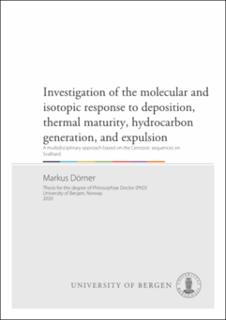| dc.contributor.author | Dörner, Markus | |
| dc.date.accessioned | 2020-05-13T11:47:34Z | |
| dc.date.available | 2020-05-13T11:47:34Z | |
| dc.date.issued | 2020-05-20 | |
| dc.date.submitted | 2020-05-12T08:36:52.889Z | |
| dc.identifier | container/d0/e4/bf/4c/d0e4bf4c-3623-47c0-b7e2-2686ac8be2a7 | |
| dc.identifier.uri | https://hdl.handle.net/1956/22229 | |
| dc.description.abstract | Understanding the generation, expulsion and migration of hydrocarbons and the associated effects on the molecular composition of generated products plays a major role in petroleum system analyses. The presented PhD study is based on a research well from the Central Tertiary Basin of Svalbard which has not been investigated in detail previously. The core material from this well is of exceptional quality. A comprehensive depositional reconstruction of the lithologies of the research well has been established by combining inorganic and organic geochemistry. Shedding a light on the effects of sulphate reduction on the preserved organic matter quality supported a better understanding of the depositional settings and natural quality limitations on the present-day organic matter concentration. The effects of thermal maturity on the organic matter and on selected biomarker compounds as well as on molecular maturity proxies has been investigated. The implementation of multivariate statistics has led to the creation of a novel unitless biomarker maturity trend. Molecular fractionation effects associated with the expulsion and migration of hydrocarbons have been investigated. The findings show that polar compounds and asphaltenes were preferentially retained in the organic rich layers of the lower Frysjaodden Fm. On the other hand, the expelled hydrocarbons have migrated upwards and mainly consist of saturated compounds of low polarity. The development of an advanced maturity-based back calculation approach made it possible to calculate the amounts of hydrocarbons that have been generated, expelled and migrated with respect to their initial organic matter quality and quantity. In addition to the geoscientific investigations, two analytical methodologies have been developed in the course of this PhD project. The first methodology involves the multiple detector coupling to a single gas chromatograph in order to enhance the data density per injection and significantly reduce the sample preparation work for organic geochemical analyses. The second method is used to monitor the isotopic composition of the Rock Eval S1 and S2 parameters in an online analysis. This analytical setup was described for the first time. The results support a better understanding of isotopic fractionation effects introduced by thermal maturation and hydrocarbon generation and expulsion. The results from these analyses have also been used to confirm the impact of sulphate reduction on the reactive organic matter proportion in the Paleocene Eocene transition of the investigated well. | en_US |
| dc.language.iso | eng | eng |
| dc.publisher | The University of Bergen | en_US |
| dc.relation.haspart | Paper I: Dörner, M., Berner, U., Erdmann, M., & Barth, T., (2018). Organic geochemical research analytics of the petroleum industry: enhanced data density and method flexibility using gas chromatograph multiple detector coupling. Geological Society, London, Special Publications, 484, SP484-6. The article is not available in BORA due to publisher restrictions. The published version is available at: <a href=" https://doi.org/10.1144/SP484.6" target="blank">https://doi.org/10.1144/SP484.6</a> | en_US |
| dc.relation.haspart | Paper II: Dörner, M., Berner, U., Erdmann, M., & Barth, T., (2020). Geochemical characterization of the depositional environment of Paleocene and Eocene sediments of the Tertiary Central Basin of Svalbard. Chemical Geology, 542, June 2020, 119587. The article is not available in BORA due to publisher restrictions. The published version is available at: <a href="https://doi.org/10.1016/j.chemgeo.2020.119587" target="blank">https://doi.org/10.1016/j.chemgeo.2020.119587</a> | en_US |
| dc.relation.haspart | Paper III: Dörner, M., Berner, U., Erdmann, M., & Barth, T., (2019). Carbon isotopic analysis of reactive organic matter using a new pyrolysis-cryotrapping-isotope ratio mass spectrometry method: The isotope variation of organic matter within the S1 and S2 peaks of Rock-Eval. Organic Geochemistry, 136, October 2019, 103886. The article is available in the main thesis. The article is also available at: <a href=" https://doi.org/10.1016/j.orggeochem.2019.06.007" target="blank"> https://doi.org/10.1016/j.orggeochem.2019.06.007</a> | en_US |
| dc.relation.haspart | Paper IV: Dörner, M., Berner, U., Erdmann, M., & Barth, T., (2019). Organic geochemical characterization of hydrocarbon generation and migration at the Paleocene-Eocene transition on Svalbard. The article is not available in BORA. | en_US |
| dc.relation.haspart | Paper V: Dörner, M., Berner, U., Erdmann, M., & Barth, T., (2020). Qualitative evaluation of molecular maturity markers in thermally mature sediments, a case study from Svalbard. The article is not available in BORA. | en_US |
| dc.rights | In copyright | eng |
| dc.rights.uri | http://rightsstatements.org/page/InC/1.0/ | eng |
| dc.title | Investigation of the molecular and isotopic response to deposition, thermal maturity, hydrocarbon generation, and expulsion : A multidisciplinary approach based on the Cenozoic sequences on Svalbard | en_US |
| dc.type | Doctoral thesis | |
| dc.date.updated | 2020-05-12T08:36:52.889Z | |
| dc.rights.holder | Copyright the Author. All rights reserved | en_US |
| dc.contributor.orcid | https://orcid.org/0000-0002-9236-1836 | |
| fs.unitcode | 12-31-0 | |
